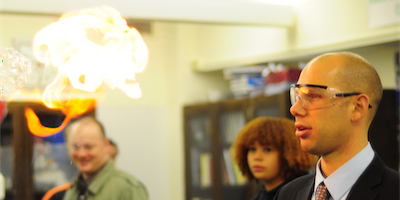Name: Ramsey Musallam (@ramusallam | www.flipteaching.com)
School: Sacred Heart Cathedral Preparatory & University of San Francisco
Current title: Science Department Chair and AP Chemistry teacher at Sacred Heart Cathedral Preparatory, adjunct faculty in the School of Education at the University of San Francisco
Selected accolades: Techsmith’s “Top 20 Educators to Watch“, Google Certified Teacher, Best of CUE Presenter 2010
What is the best part of your job?
I absolutely love the creative side of lesson planning. Unlike many other professions, educators must create the work that they implement in their workspace (the classroom and online). This creative process is where technology, and other exciting mediums empower teachers to best serve students and design engaging pedagogy. The challenge of creating and refining a lesson energizes me constantly!
From where do you draw professional inspiration? How do you stay connected and grow as an educator?
Chemistry often serves as roadblock for future careers in the health sciences for many capable students, and making the subject accessible for all learners is central to my work as a teacher. Creating learning environments using multimedia (specifically tablet and screencast technology) that help address the complexity of chemistry is something I am very passionate about.
My research in graduate school focused on designing learning environments to manage intrinsic cognitive load in chemistry instruction (information complexity), without sacrificing rigor and content. Each time I share my work in this area, whether it be at a conference, workshop, or informally online with a fellow educator, I am greatly inspired.
What skill(s) do you feel are most important for today’s students to explore in academic settings (tech or non-tech related)?
Eric Mazur, Physics professor at Harvard said: “Their are two parts to education. One, information transfer, and two, information assimilation. Because students today can easily access an infinite amount of information, our job as educators is to help students assimilate their knowledge in meaningful ways.”
Mazur’s quote speaks directly to what I think is most important in education. We must empower students to become intelligent researchers and investigators of information, harnessing the power of the internet and their global community, to learn in ways the traditional classroom could never have granted them. Simultaneously, we must use the classroom as a medium for critical thinking and information assimilation, rather than information transfer. As a result, students become empowered to obtain a depth of knowledge while teachers are empowered to design learning environments that value critical thinking and application.
What does an efficient, effective educational system look like on a day to day basis?
An efficient and effective system is one that sees one day with a student as a 24 hour period of time, rather than from bell to bell.
An efficient system is one that understands how students learn best, through both an emotional and cognitive lenses, and uses both in class and home time wisely. For example, rather than assigning practice for the homework setting, and direct instruction for the classroom, teachers could “flip” this model*, and harness various technology tools to bring information transfer to the homework setting and use the classroom for practice and application. This would maximize meaningful learning in class, while also giving students direct, cataloged, interactive and one-on-one instruction at home. Thus, no time is wasted, and students can learn at their own pace, while teachers are granted the time they need in-class to work with individual student and value their various needs.
*Editor’s note: To learn more about Ramsey’s instructional style and technology use with intention, read this companion article: Time-shifting instruction: flipped teaching and classrooms.

Ramsey’s ideas are genius, inspiring and selfless. It is no mystery why he is and will CONTINUE to be an amazing teacher!!
I’m continually impressed by how student-centered this method is. I’m inspired by Ramsey and his passion for engaging students while they are in class and hope to incorporate more flip teaching in my own class.
Great post, thanks.
What an inspiring profile of a teacher who seems to be truly excited about his work. At a time when many complain about the quality of education, it is encouraging to know that we have educators like Ramsey in our midst. The world needs to know about Ramsey and his colleagues.
Pingback: Time-shifting instruction: flipped teaching and classrooms | Technology with Intention
I had Mr. Musallam as my AP chem teacher, and I must say, he is a great teacher. He makes the normally suffer-inducing class fun, and I always looked forward to his class. His masterful weaving of technology and school subjects is a method that should be adopted by teachers in all subjects. The new generation of kids are technology based, and it will help them connect to the subject better.
Pingback: Screencasting Apps for the iPad | Technology with Intention
Pingback: Announcing FlipLab – a 21st century professional development experience | Technology with Intention
Pingback: Technology with Intention | Learning, feedback, validation